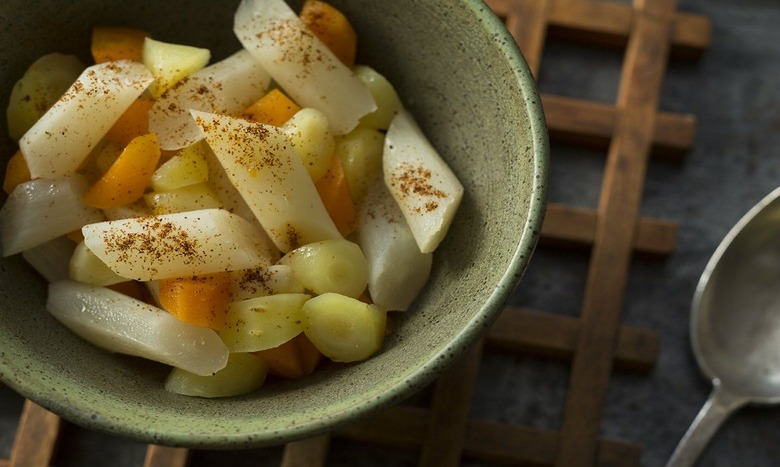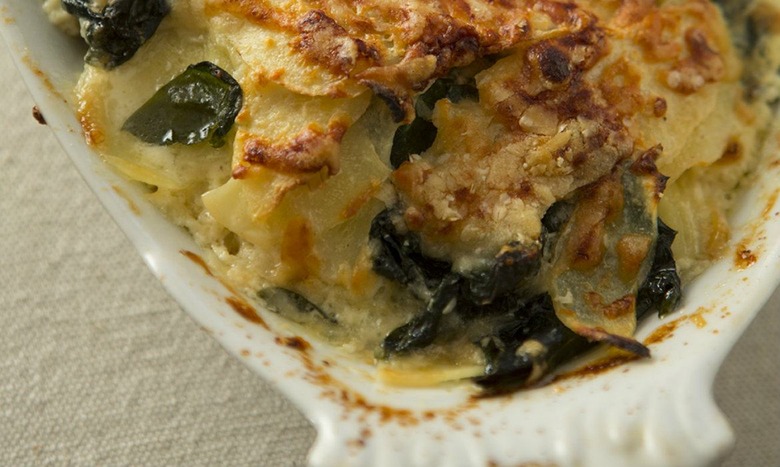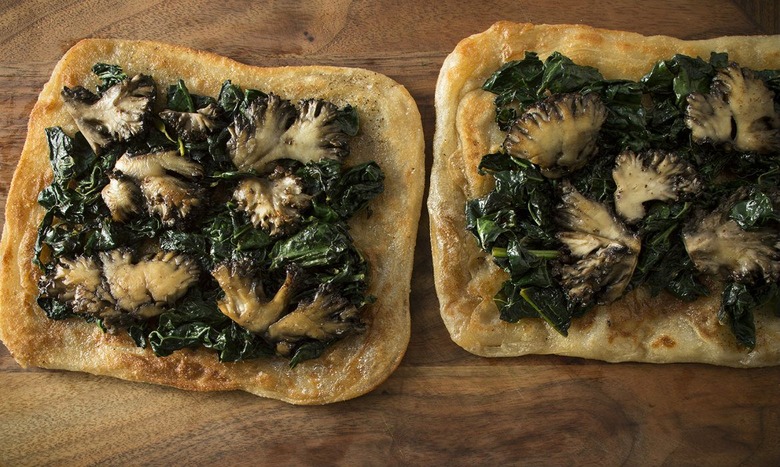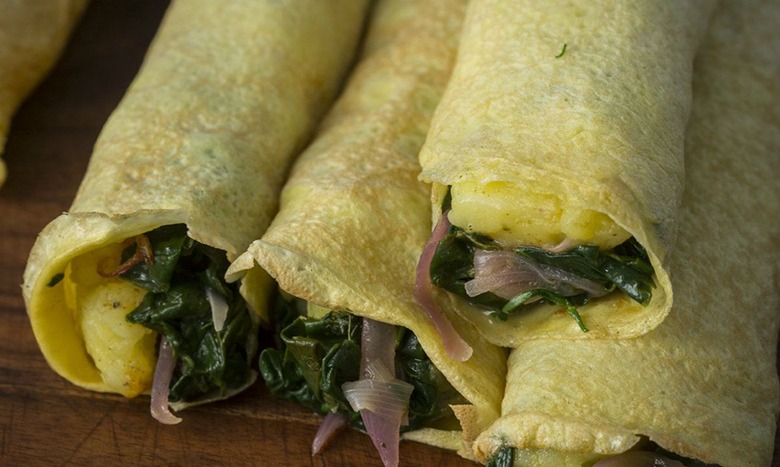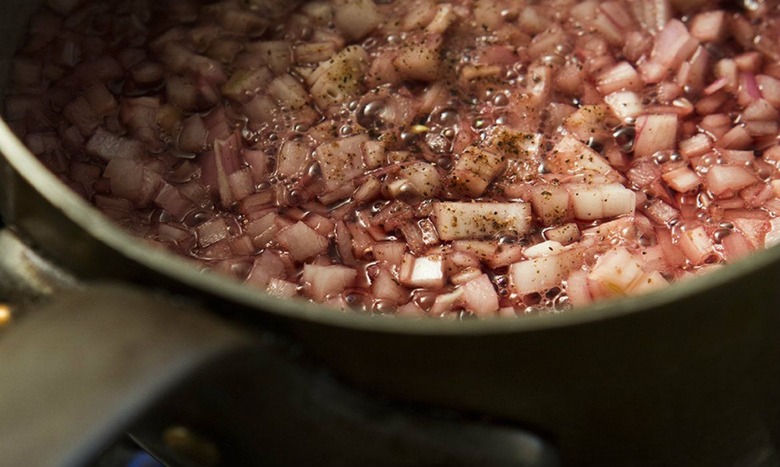'V Is For Vegetables' Will Have You Falling For Vegetables
We may receive a commission on purchases made from links.
"I didn't want this book to turn out too chef-y" said executive chef Michael Anthony about his latest cookbook, V is for Vegetables. Anthony continued, "The guiding principles were does [the food] taste truly delicious and are [the recipes] realistic for a home cook to make."
Click here for the 10 Cookbooks Everyone Should Have slideshow.
Anthony's latest cookbook is a departure from his previously published collection, The Gramercy Tavern Cookbook, which included recipes from the restaurant he owns along with the restaurateur Danny Meyer.
This book is entirely focused on the home cook, and it shows. From the thoughtful introduction from Anthony that is accompanied by a picture of the chef sans whites, to the easy-to-follow alphabetized recipes, Anthony guides readers. He breaks down otherwise intimidating cooking lingo, like how to blanch vegetables or use a mandoline to cut razor thin radishes to open up a world of vegetable possibilities for readers. But, Anthony also emphasizes the importance of trusting your own instincts in the kitchen when it comes to choosing produce and seasonings.
Anthony chose to include recipes that he explained wouldn't necessarily ever be found on one of his restaurant menus, like a simple roasted kohlrabi, prepared by peeling it, quartering it, roasting in extra-virgin olive oil, and seasoning with a little smoked paprika. It is "dynamite," according to Anthony, and exactly how he would prepare the dish at home.
We had the opportunity to catch up with Anthony and discuss his inspiration for the book and how to make vegetables lovable:
The following interview has been edited for content and clarity.
The Daily Meal: What is your general philosophy on cooking?
Michael Anthony: The general philosophy has always been to create seasonal menus that are distinctive to the place that I am cooking. I have been in the New York area for the last 20 years or so. It is adding to the dialogue of contemporary American foods in a discreet and refined way. So in a way, V is for Vegetables is an evolution of that general approach.
And how did that philosophy affect the recipes you included in this book?
This book is all about focusing on vegetables as a vehicle for accomplishing that exact mission. It's a way of expressing that excitement and inspiration that I get from all the beautiful flavors, shapes, and colors of locally grown vegetables.
The only guiding principles that went into selecting what recipes went into this book was one: Was it easy enough to cook at home? Was it sincerely a dish the average American would feel comfortable cooking at home. Two, is it a vegetable? Does it express something interesting about cooking with vegetables? Remember, that doesn't necessarily exclude fish or meat, its not a book about vegetarianism or veganism, its about whether or no a dish says something exciting about a particular vegetable. And, they needed to be delicious. I cooked each one of these dishes as we shot [photos] for the book.
There was a lot of contribution from the team. You know I've only done the one other cookbook, The Gramercy Tavern Cookbook, and I don't know how other people work, but I dealt with a certain amount of pressure to make sure they tasted delicious. And then, there was a lot of surveillance going on to make sure nothing turned out to be too chef-y.
We knew from the beginning that this book had to be absolutely sincere. So there is a ton of voice that is encouraging and coaxing home cooks — saying you can't mess this up. Let me give you a few tips, a little explanation, or sometimes introducing people to vegetables they may not be familiar with or creating new flavor profiles with ingredients they are familiar with. All the while, the book is meant to get more people cooking at home.
Why do you think people, particularly meat eaters, have a hard time envisioning vegetables as a main course?
I think I grew up in the same way most people did. We kind of have an instilled animosity [toward] vegetables. I think that it probably has to do with the fact that, from the last few generations we've grown up being introduced to vegetables that were not always supremely fresh. So there wasn't a lot of excitement.
I was the pickiest eater on the planet, and the reality was that when I started traveling, and experiencing new places and new cultures, there was a real interest in eating vibrant foods that express rationality, and say something about what is different about eating here.
Writing this book also brought me back to the notion that my grandparents loved eating from their gardens. Then, as a professional cook I realized that when you are really looking for great flavors it comes from foods that are alive.
When it comes to thinking about great meals, they come from things that are grown around here that are distinctive that you can't get when you travel to other places.
I think there is also a time factor. Like okay, you want me to take this pile of knobby Jerusalem artichokes, and peel these things, and actually try to make something with it? So there is a certain inaccessibility that comes with the how in the world do you — we called it this in the book — unzip vegetables and make them usable. How do you cut up an artichoke? A piece of celery root or rutabaga is a little daunting. How do you turn that into dinner?
Lastly, for people who already know they like vegetables, what are the little sauces and seasoning tricks that kind of make them lovable? So, I wanted to share all of that for people.
You know, I am a dad, I have three girls, so it's not like it's an easy thing being a cook. It's always hard when you put yourself out there and you are responsible for putting a meal on the table.
I really wanted to encourage people with information that would help them feel connected to their kitchen and feel confident that they can make people happy by using seasonal vegetables, and feel that source of information that I get when I'm walking to the green market.
What is your advice for people who are intimidated by less familiar vegetables like Jerusalem artichokes and salsify?
One, it's not quite as hard as you might think. There are some really nice process pictures in the book that show everything, like how I organize my cutting board with comments like buy a cutting board that is a little larger than most people have at home so that you can organize your work like a real cook.
Here is how to peel them, and in a lot of cases, here is what you don't have to do. You can eat the skin of this vegetable, so rinse it, give it a scrub, and then roast it whole because it's most delicious that way. I gave people little tips and background stories about how I fell in love with eating those things. Hopefully, it's through my experience with eating and traveling that people might find a little connection to the food.
Then, there is a certain kind of lovability about even hard to love vegetables, like Jerusalem artichokes because they grow here. When you are trying to put healthy food on the table, you can't really find these vegetables when you are sourcing from stores and more conventional places. You really do have to go to the farmer's market and support your local farmer. Ask questions, like "how did you grow these things? Why did you grow them?" When you learn that a Jerusalem artichoke is the tuber of a plant in the sunflower family that grows seven feet tall and has the most gorgeous yellow flower, I don't know there is a little attachment that forms when you see it within the context of how it grows and how it acts. There is inherent beauty in it.
One, name it. Here are vegetables you may not be familiar with, here are some flavors that are truly delicious, and here is the way to unzip them or make them accessible, and lastly here are tips on how to season them so you have a chance to truly fall in love with them.
Want to try a recipe?
Glazed Salsify and Carrotsroot vegetables
Salsify is a vegetable whose flavor improves immensely with a light touch of garlic and butter. This recipe is a classic way to glaze . — Michael Anthony
Parsnip and Kale Gratin parsnips
I use a classic rich combination of cream, butter, and garlic to draw out the seductive qualities of soft and kale. Together, they make a decadent, delicious dish. — Michael Anthony
Sautéed Mushrooms Flatbread with Braised Greensflatbread
Two simple gestures deliver so much. Take a crispy (or cracker or even grilled bread) and top it with something soft and garlicky, like sautéed mushrooms, then add greens like kale, spinach, or chard. It's the best kind of open-face sandwich — the bread captures the vegetables' succulent juices. I like to use cultivated hen-of-the-woods or maitake mushrooms for their texture. — Michael Anthony
For the Sautéed Mushrooms Flatbread with Braised Greens recipe, click here.
Spinach Egg Crêpes
Eating spinach sometimes leaves a funny feeling in peoples' mouths, caused by the oxalic acid in the leaves. Nigel Slater, a British food writer I admire, calls it "furry teeth." Lemon juice can soften that effect and mellow its flavor. These crêpes are a wonderful way to highlight many garden greens—kale, collards, chard—and are filled here with potatoes, too. I often add other ingredients to the filling, such as grains, peppers, fish, or meat. — Michael Anthony
Sweet and Sour Shallots
This amazing condiment can enliven grilled, fried, steamed, and raw foods. It enhances and amplifies the shallots' inherent qualities. Since the shallots are cooked with vinegar, the condiment keeps for a long time and is a great homemade preparation to brighten all sorts of dishes, such as fried oysters. — Michael Anthony
Winter Squash Stuffing
Somehow Thanksgiving stuffing can be the best thing on the holiday table. I use winter squash combined with mushrooms to make a delicious dish for our celebration or for any day of the week. — Michael Anthony
For the Winter Squash Stuffing recipe, click here.
Angela Carlos is the Cook Editor at The Daily Meal. Find her on Twitter and tweet @angelaccarlos.
